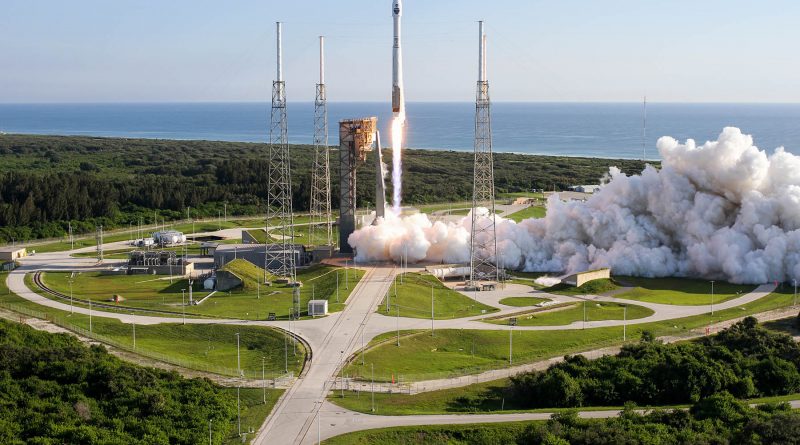NASA’s Newest Tracking & Data Relay Satellite Sails into Orbit aboard ULA Atlas V Rocket
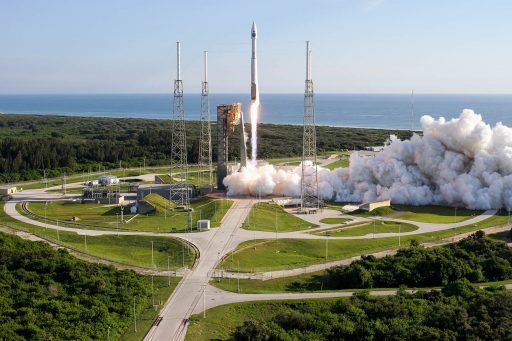
The rumble of an Atlas V rocket returned to Cape Canaveral on Friday after a four-month gap when ULA’s workhorse rocket blasted off with critical reinforcement for NASA’s Tracking and Data Relay Satellite System, providing extension coverage to maintain the agency’s prime space communications program well into the next decade.
TDRSS builds a critical life line for astronauts aboard the International Space Station, delivers images from the Hubble Space Telescope and NASA’s flagship Earth Observation Missions, and over 40 other scientific satellites as well as national security assets, aircraft and remote research stations in Antarctica. TDRS-M, the newest communications relay hub, will join the constellation as the final member in the third generation of TDRSS satellites, providing a boost in overall network capacity to handle ever-growing user demands, and ensure TDRSS can remain in service until the Space Station’s expected retirement.
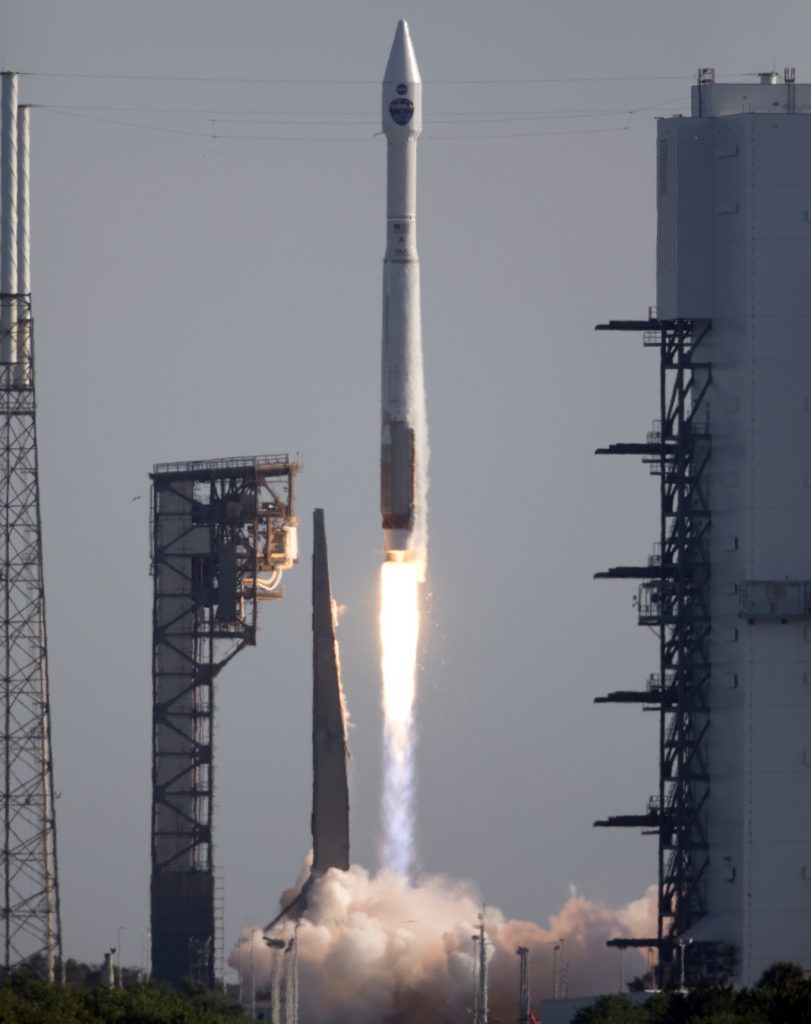
Atlas V – flying for the fourth time this year – thundered off from Space Launch Complex 41 at 12:29 UTC, 8:29 a.m. local time, rising into clear skies under the power of its two-chamber RD-180 engine that powered the vehicle until the first stage dropped away just over four minutes into the mission.
Assuming control of powered flight, the trusted Centaur upper stage was tasked with a customized mission profile to deliver TDRS-M to an optimized drop-off point – requiring a lengthy initial burn of over thirteen and a half minutes followed by a one-and-a-half-hour coast phase to set up for a short but critical re-start that lifted the 3.5-metric-ton satellite into its target Geostationary Transfer Orbit.
Loaded springs pushed the spacecraft away from the Centaur upper stage one hour and 54 minutes after Friday’s launch and the craft checked in with ground stations to set the stage for a ten-day climb into Geostationary Orbit where its velocity will match that of Earth’s rotation to allow the satellite to remain in a fixed position in the sky. TDRS-M will be re-named TDRS-13 upon reaching operational status around five months after launch, entering the constellation over the Atlantic to deliver additional capacity to deal with growing user demands.
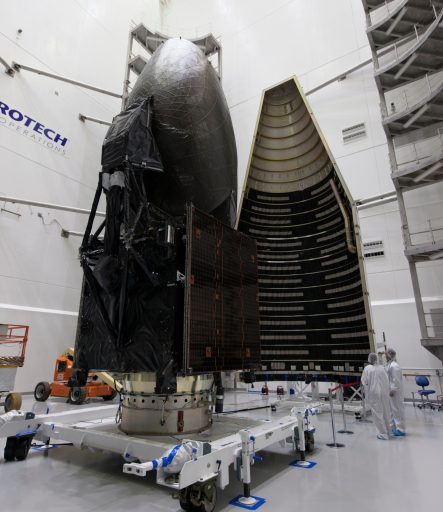
The Tracking and Data Relay Satellite System (TDRSS) was established in the 1980s after NASA identified the need for near-constant coverage of the Space Shuttle’s orbit to remain in touch with the astronauts on board. Before TDRSS, NASA used a series of ground stations that only provided sporadic coverage, considered sufficient for robotic probes and satellites but making for some tense gaps in communications during the early Mercury and Gemini missions.
TDRSS functions by deploying a series of communication relay satellites in three locations in Geostationary Orbit, over the Atlantic (TDRS-East), Pacific (TDRS-West) and TDRS-Z over the Indian Ocean, covering what is known as the Zone of Exclusion – a small blind area between the eastern and western satellites. Featuring different antennas, the satellites relay data from lower-orbiting spacecraft to ground terminals in Guam and New Mexico from where data is routed to the respective users.
The most prominent user of TDRSS is the International Space Station, using high-rate communications to beam down a plethora of video and data feeds from dozens of scientific experiments on the inside and outside of the complex while low-rate communication links are used to provide a near-continuous voice link between Mission Control and the crew. TDRS also provides standard-of-living services for the crew like video-conferencing with their families, TV uplink and Internet access, using TDRS as a relay from the ground to a LEO spacecraft.
>>TDRS-M & TDRSS Constellation Overview
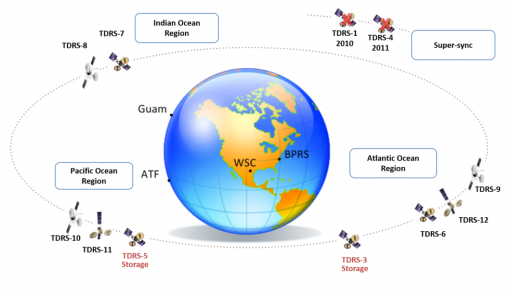
Beyond ISS, TDRSS supports other NASA flagship missions like the Hubble Space Telescope and the Landsat program that has kept watch over Planet Earth for over four decades. All in all, TDRSS is relied on by dozens of NASA missions and other users like the Department of Defence to keep in contact with some of its classified space assets.
A total of 13 TDRSS satellites were launched since 1983 – six of seven first generation satellites were successfully orbited by the Space Shuttle (one was lost in the Challenger accident), three second-generation satellites were lifted by Atlas IIA rockets and three third-generation satellites launched between 2013 and 2017. TDRS-M joins nine satellites that remain in service, seven as part of the active constellation and two older ones are in a position to be called upon as spares.
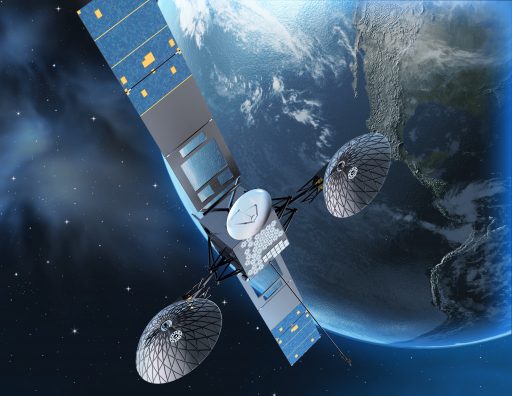
In addition to covering satellites in orbit, TDRSS also relays communications for aircraft, balloons and remote ground stations as well as rockets on their way into orbit. In fact, Friday’s TDRSS launch was supported by TDRS-12 that made its way into orbit on an Atlas V three years ago and this time covered the first Centaur burn while TDRS-7 provided communications in the later stages of flight when Centaur was over the Indian Ocean.
The three third-generation TDRSS satellites are essentially carbon copies with TDRS-M being the 76th and final Boeing BSS-601HP satellite to leave Earth. Once among the most popular communications satellite platforms, BSS-601 has been replaced with the much-improved 702 series but NASA decided in 2007 when ordering TDRS-K and L to stick with the well-proven 601 platform and TDRS-M was ordered in 2011 to follow suit.
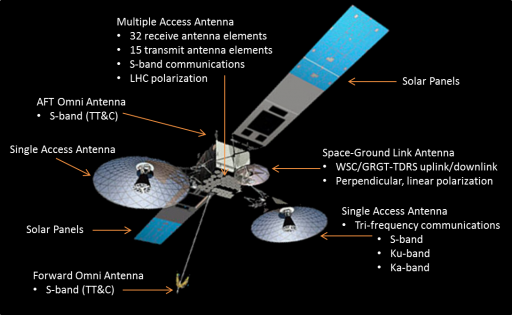
TDRS-M, often likened to certain kinds of florals or cocooned insects with its antennas and appendages stowed, weighs in at 3,454 Kilograms and stands 8 meters tall when packed for launch. Once in orbit, the craft will deploy a pair of power-generating solar arrays, two 4.6-meter mesh antennas for single-access, high-rate links, a 1.9-meter antenna facilitating the space-to-ground-link and a phased array on the Earth-facing side will provide multi-access links to several spacecraft at the same time. Each single-access antenna supports one spacecraft at a time, typically the ISS (when in view) and one other craft – used for high-data rate burst downlink of stored onboard data.
Single-access services are available in three bands – Ku/Ka-Band is employed for very high data rates up to 800 Mbit/s for the return link and S-Band rates can be as high as 25 Mbit/s. Multi-access allows each TDRSS satellite to receive and send data to up to five other satellites at the same time.
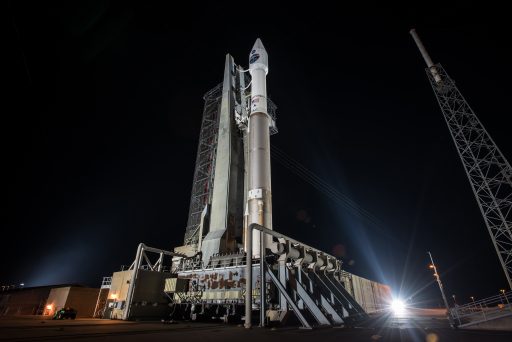
TDRS-M comes with a price tag of $289 million, awarded to Boeing under a fixed-price contract as NASA exercised its option for a third satellite, foregoing an additional option for a possible TDRS-N. The craft’s launch contract was awarded to ULA in 2015 for $132.4 million.
Friday’s launch of Atlas V AV-074 was preceded by a smooth countdown for the workhorse launcher, starting just after 1 a.m. local time to power up the two-stage rocket and press into a lengthy testing operation to verify all systems were in readiness for the mission. Range instrumentation was set up and radio checks with Atlas V were performed around the L-4-hour mark followed by the final close outs at the launch complex to clear the way for fueling.
Cryogenic tanking picked up when the countdown resumed from a 15-minute pause at the T-2-hour mark to load Atlas V with Liquid Oxygen oxidizer and Liquid Hydrogen fuel. 94,600 liters of Rocket Propellant 1 had been filled into the first stage after Wednesday’s rollout, leaving only the supercold cryogenics to be loaded during the count – a sequence taking 90 minutes.
>>Atlas V Launch Vehicle Overview
Tanking was by the book as the first stage received some 185,000 liters of the -183°C oxidizer while the second stage was loaded with 15,700 liters of LOX and 48,100 liters of the even colder LH2, stored at -253°C.
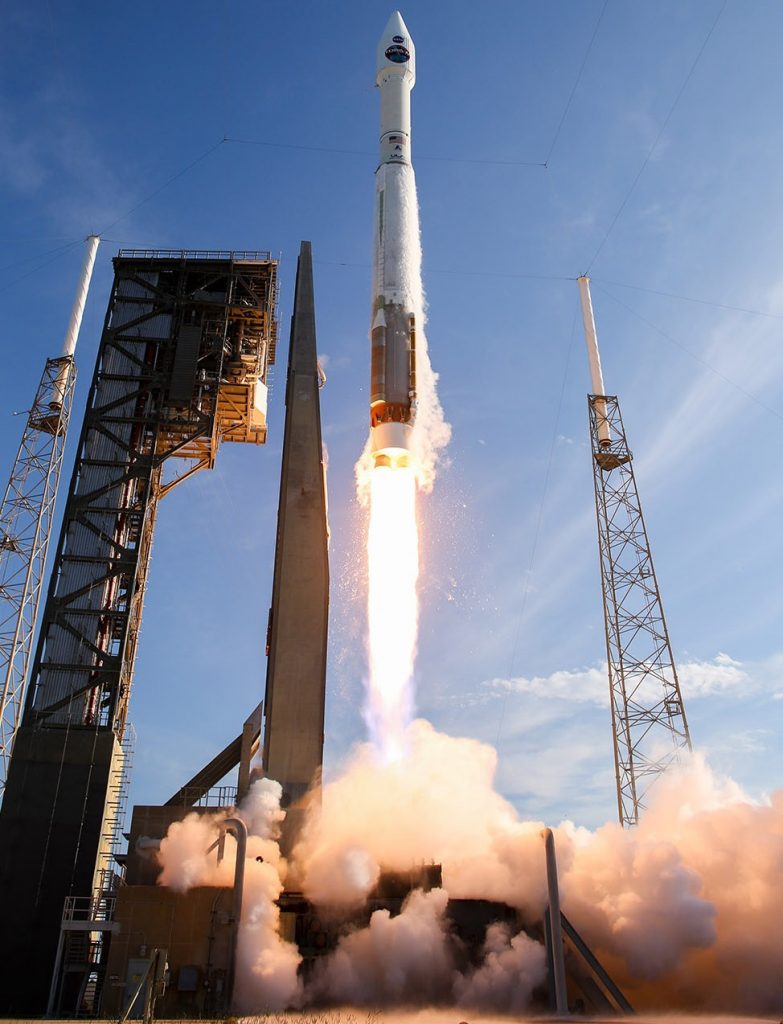
With all tanks in topping and a refined version of the flight profile uploaded to Atlas V, the vehicle entered some final preparations for automated countdown while TDRS-M switched to battery power to be ready for its climb to orbit.
The launch had to be pushed into the day’s launch window opening at 12:03 UTC due to an anomalous condition on the RL-10C engine of the Centaur upper stage that was slow to reach the required temperature on its oxidizer turbopump. The issue was traced back to a ground support line and teams adjusted the engine’s chilldown pressures to coax the pump temperature into the desired range. This delayed liftoff by 26 minutes.
With issues resolved and excellent weather, all support stations provided a unanimous GO to allow Atlas V to enter the fast-paced four-minute auto sequence to pressurize its tanks, arm the Flight Termination System, switch to battery power and take over control from ground systems for the final automatic checks leading up to engine start.
The Russian-built RD-180 ignited at T-2.7 seconds in a carefully controlled sequence to reach a launch thrust of 390 metric-ton-force to lift the 335-tonne vehicle off its pad. Computers verified RD-180 was running smoothly before releasing the 58-meter tall Atlas V rocket to begin its climb into orbit.
With no Solid Rocket Boosters, Atlas V made the typical graceful liftoff – gimbaling the two nozzles of the RD-180 to keep the rocket in a vertical posture for the first 18 seconds of the mission. The NPO Energomash engine showed stable performance as Atlas V swung to the south-east, pitching and rolling to begin its trek toward Geostationary Transfer Orbit.
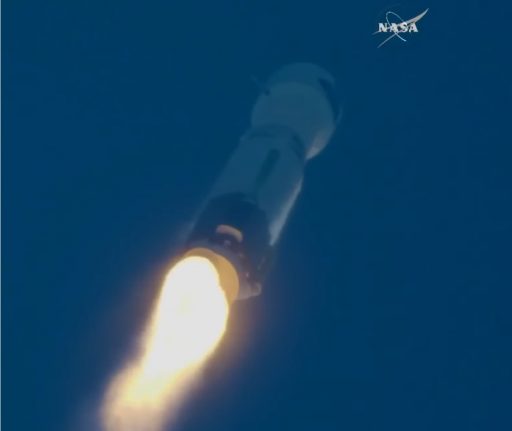
Atlas V pushed through the sound barrier after eighty seconds, encountered Maximum Dynamic Pressure at T+1:32 and had shed half its liftoff weight two and a half minutes into the flight as the RD-180 continued guzzling down 1,150 Kilograms of propellant per second.
BECO, Booster Engine Cutoff, was called four minutes and two seconds after liftoff with RD-180 gradually throttling back in the closing seconds of its burn to limit acceleration on the vehicle. Cutting charges separated the spent Common Core Booster and the 32.5-meter long first stage was pushed clear of Centaur by eight small retrorockets.
Performance on the CCB was noted as near-nominal, within pre-flight predictions.
The trusted Centaur upper stage – conducting its 243rd mission – immediately headed into purging of its reaction control system and pre-started the RL-10C engine before ignition four minutes and 18 seconds into the flight. Just eight seconds later, Atlas V split open and dropped its payload fairing as the vehicle had reached the tenuous upper atmosphere were aerodynamic forces could no-longer hurt TDRS-M’s delicate mesh antennas.
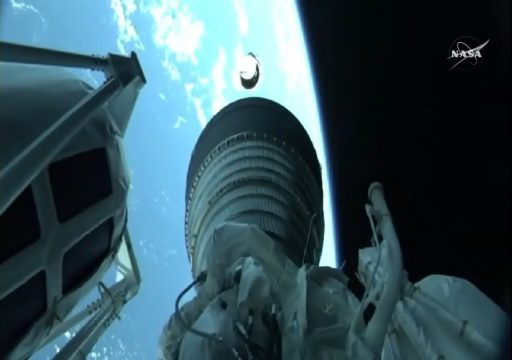
Centaur conducted a lengthy first burn, firing the 10,400kgf RL-10 engine for just over 13 and a half minutes to reach an elliptical Parking Orbit as part of a customized mission design. The burn went by the book and Centaur settled down in an orbit of 183 by 25,680 Kilometers, 27.0° for a coast phase of 90 minutes.
The coast phase was extended over past TDRS missions on Atlas V to optimally use the recently-introduced RL-10C engine and reach the best possible injection orbit. In essence, extending the coast by eight and a quarter minutes bought the satellite an additional two years of service life by delivering it to a higher-energy injection orbit and so save fuel on the climb into GEO.
While coasting, Centaur finished its Atlantic-crossing, flew over Sub-Saharan Africa & Madagascar and then headed out over the Indian Ocean as it gained altitude – targeting the second burn slightly over the halfway-point up to the high-point of the Parking Orbit. Re-start of Centaur was confirmed one hour and 48 minutes into the flight and the burn ran the expected 56 seconds. Navigation data from the upper stage showed an injection orbit of 4,644 by 35,790 Kilometers, 26.23 degrees – very close to the target 4,640 x 35,788km, 26.2° orbit.
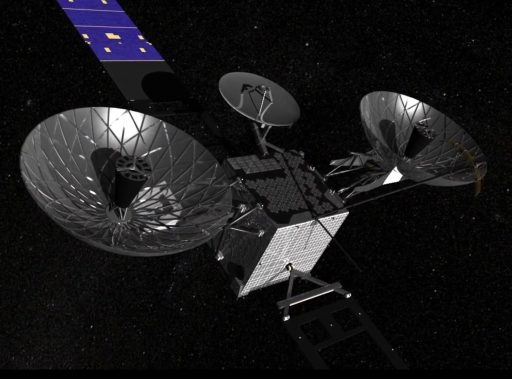
TDRS-M separated from Centaur one hour and 54 minutes into the flight and checked in with a tracking station in Australia just over a minute after deployment, sending back status telemetry to confirm its health in orbit. Engineers will conduct detailed tests of the satellite before beginning a series of apogee-maneuvers with its R-4D engine to spiral up from its elliptical drop-off point into the Geostationary Belt over the equator to begin five months of testing ahead of at least 15 years of active service.
Friday’s launch was the 72nd for the Atlas V since its inauguration in 2002 and the 120th mission for United Launch Alliance. It was the 37th flight of the Atlas V 401 variant, the 50th of the Atlas V 400 series and the 59th Atlas V from Cape Canaveral. It also marked the 654th launch of a vehicle named Atlas, going back to the early days of space flight in 1957.
ULA fans will not have to wait another four months for the next mission as a series of launches is lined up before the end of the year, involving Atlas V, Delta IV and Delta II vehicles. The next missions on the manifest are two secretive deliveries for the U.S. National Reconnaissance Office in September from Florida and California, pending readiness of the payloads.

